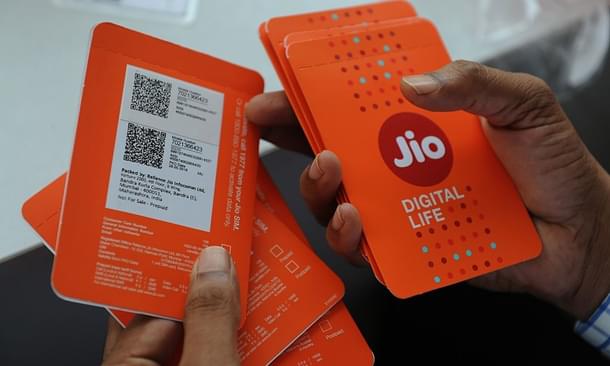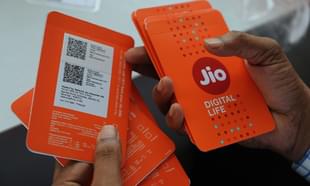Business
How Much Will Jio Get Out Of Its Free Voice Call Offer?
Sindhu Bhattacharya
Dec 27, 2016, 02:24 PM | Updated 02:24 PM IST
Save & read from anywhere!
Bookmark stories for easy access on any device or the Swarajya app.


Reliance Jio’s offer of free voice calls for life has been a disrupter in India’s telecom market, where almost three-fourth of the revenue market share lies with the incumbents, who happen to be the three biggest telecom operators. Voice still accounts for roughly 70 per cent of the industry’s revenue so when Jio offered voice calls for free, for life, at its launch in September, the dynamics of the market changed overnight. Here’s how this works for Jio going forward, and for the incumbents Bharti Airtel, Vodafone India and Idea Cellular:
What is the Jio offer all about?
Jio launched operations in September with a ‘Jio Welcome Offer’ which gave users access to unlimited LTE (4G) data and national voice, video and messaging services besides Jio applications and content, free of cost up to 31 December. This offer has now been extended to 31 March next year. The highlight of the Jio bouquet was free domestic voice calls to any network across the country, for life. The company said after the launch announcement that average data prices would be around Rs 50/GB, claiming these were amongst the lowest in the world. The telecom company also claimed that it has introduced a simple tariff structure with only 10 main plans against 22,000 tariff plans prevailing in the country at that time. Jio also began selling 4G compliant Lyf devices starting at Rs 2,999.
Why is Jio offering voice, the biggest revenue generator for the industry, free forever?
Jio was a new entrant in a fiercely competitive market and it did what any new entrant would do in such a situation: it offered a significant price differentiation. “Freebies by entrants are the norm. Jio obviously wants consumers to abandon their existing service providers and come to its network. Since voice and data are plain vanilla offerings, it cannot expect to succeed without a competitive price. By offering voice calls and data services, Jio has managed to hurt competitors’ revenues since the latter have little choice but to match prices,” says Mahesh Uppal of ComFirst India. The incumbents have had to also offer packs where voice calls come for free and the consumer pays only for data. They have also had to lower data charges.
How can Jio afford to offer unlimited free voice calls when incumbents cannot?
Jio has entered the business with a new, up-to-date 4G network. 4G networks are optimised for carrying data, they are significantly more efficient in offering huge data capacities. Voice is carried over 4G network as data. Technically it is called VoLTE (Voice over LTE). Voice in the LTE form is packetised, unlike 2G voice which is "circuit switched". In layman's term, "circuit switched" voice calls are inefficient as they block network resources even when the line is held unused. On the other hand, in a similar situation, packet switch calls free up resources dynamically for other users, thereby significantly increasing network efficiency.
Also, 4G technology uses more advanced techniques for increasing efficiency, which are not supported by 2G. Hence, for a 4G operator, voice ends up consuming a very small fraction of the network resource compared to what is used to offer data. This is why the cost of carrying voice on a 4G network is much lower compared to a 2G network – where the network resources have to be increased linearly with rising voice calls – resulting in more investments – making it difficult for a 2G operator to offer "unlimited voice".
This EPW piece explains that the three incumbent telcos have invested heavily in older second-generation (2G) and third-generation (3G) technological platforms. And that at present, Jio is the only telecom operator in India with fully data-centric services, entirely based on voice over long-term evolution VoLTE technology, which allows voice to be transferred over an internet protocol (IP) network at much faster speeds in comparison to traditional networks using 2G and 3G technologies. Jio treats voice as data – VoIP (Voice Over Internet Protocol) – and sends the voice communications through the networks as packets. For incumbent operators, on the other hand, only a small part of their voice traffic is transmitted as data. So the most important thing which works for Jio is that the tech prowess enables it to offer free voice calls at no extra cost.
Let it be understood upfront, however, that as of now, Jio is losing money on each voice call since it has to pay 14 paise per minute for each call originating from its own network without charging a single paisa from the consumer.
So, has Jio got a winner and will it eventually beat the incumbents at their own game?
While it is interesting to see how deploying the latest 4G technology has provided Jio the appetite to take a loss on each voice call, the marker remains challenging for the new entrant. First, incumbent telcos have begun offering packs where voice calls are free and these start at Rs 149 for all calls that are made within the operators’ own network. The advantage Jio continues to maintain here is that it continues to offer "unlimited voice" packs which include calls made to a subscriber of a competing operator's network too. But the point is incumbents are beginning to match Jio in freebies.
Second, a 4G operator running voice as data will face some challenges too, say analysts. Jio may find it difficult to offer plans with a higher validity period. And if it does, then the subscribers will end up using the data offered for making voice calls (4G voice consumes very little data), resulting in decreased ARPUs (Average Revenue Per User).
Third, the biggest challenge is the inability of the legacy 4G handsets to support VoLTE, and hence new VoLTE capable 4G handsets have to be seeded in the market. This may not happen overnight and anyway needs a significant spend by telcos wanting to buy subscriber loyalty. As of now, most subscribers on Jio network are using it as a second SIM and have preferred not to switch from their existing operator.
Fourth, unless the IUC (Interconnect Usage Charge) is lowered or brought to zero, the 4G operator offering free voice will have to recover this cost from its customer by increasing the price of data pack offered.
Sindhu Bhattacharya is a senior journalist.





